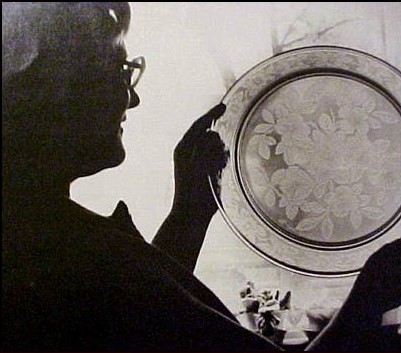
50 years and counting! Established 1973
Jayne Ann Saeger, who has been a member of the Great Lakes Depression Glass Club since its inception, remembers how it all began.
Sometime around 1972, Jayne's dad, Byron Kumler, went to a flea market and bought a luncheon set of blue Moderntone for $3.00. He had no idea what it was called, or who made it, or that it was collectible. He just knew that he liked the blue color. After all, blue was his favorite color. His grandchildren began to joke about "Grandpa and his blue dishes!"
Later in 1972 or early 1973, Jayne's mother, Clara Jane Kumler, became acquainted with Jody Cox at the beauty parlor. They both had standing appointments. Clara had acquired a set of amber dishes, having no idea that it was Madrid. After describing her amber dishes and her husband's blue dishes to her friend Jody Cox, Jody told her "That's called Depression Glass." My friend Hazel wrote a book about it. Her friend was Hazel Marie Weatherman, author of Colorful Glassware of the Depression Era, the first serious book on depression glass. Through Jody's copy of the Weatherman book, they found the names of their glassware, and searching for it became more interesting and fun.
Throughout this period, Jayne's husband Harry Saeger was in the Army, and they were stationed in Germany. When they returned home, her mom kept talking about depression glass and Jayne said "I've got some of that stuff!" When she was about 12 or 13 years old, a neighbor had given her some old pink dishes. She like them, so she put them away for her Hope Chest. She took them out and found that she had about a dozen odds and ends of pink glass. That peaked her interest, so the pretty glass became a mother and daughter interest. Jayne and her mom began going to flea markets. Jayne found a stack of green Dogwood luncheon plates for 25 cents each. That got the whole family involved.

About that time, they heard that the Michigan Depression Glass Society had formed. They went to one of their meetings. Jayne joined, but her mom did not, feeling that it was too far away. At that time, the MDGS met in Livonia and Clara lived in Troy. Clara felt that a similar club was needed on their side of town.
Jody and Jayne offered to help form a club. They talked to people at flea markets, they talked to other people with an interest in glass, and announced that they were going to have a meeting to determine if there were enough people interested to form a club. At least 20 people showed up for that first meeting. Two of the people who came were author Betty Newbound and her husband, Bill, who wrote a column called "Along the Flea Market Trail" for the newly published Depression Glass "Daze" Newspaper.
The first meeting was held at the First United Methodist Church of Troy. Jayne did a tablesetting of green Dogwood. They had an informational meeting, and everyone present agreed that a club should be formed in the area. A committee was formed to create a set of By-Laws. On April 23, 1973, they met a second time. A Constitution and By-laws were approved. The club was named Great Lakes Depression Glass Club. The first officers were:
President Clara Jane Kumler
Vice President Jesse Siebert
Secretary Lila Ashby
Treasurer Jayne Ann Saeger
Trustees Judy Cox, Dottie Kelch, & Jean Miller
They decided that they needed to find a different meeting place because their meetings were in conflict with some of the church's activities. They met for the next several years at a Methodist church in Rochester, and then at the Rochester Community Center. Since 2006, they have been meeting at their original location, the First United Methodist Church of Troy on Livernois, which had expanded since the club's inception.
Sadly, Clara Kumler unexpectedly died October 6, 1973 before the end of her first term as President, and her daughter, Jayne, assumed the role of President for the remainder of that term, and for the next 6 years. She is still a member today.
